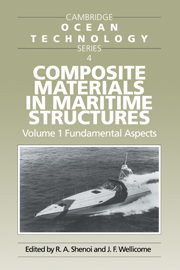Book contents
- Frontmatter
- Contents
- Preface
- List of Authors
- 1 A Strategic Overview
- 2 Background to Materials Science
- 3 Environmental Aspects
- 4 Production by Resin Transfer Moulding
- 5 An Engineering Approach to the Prediction of Elastic Properties of a Laminate
- 6 Mechanics of Orthotropic Laminae
- 7 Analysis of Laminated Composites
- 8 Theory of Sandwich Beams and Plates
- 9 Design of Anisotropic Panels
- 10 Finite Element Analysis of Composites
- 11 Theoretical Predictions of Failure Mechanisms and Strength
- 12 Considerations of Failure Theories in Design
- 13 The Procedures and Standards
- Appendix
- Index
Preface
Published online by Cambridge University Press: 04 August 2010
- Frontmatter
- Contents
- Preface
- List of Authors
- 1 A Strategic Overview
- 2 Background to Materials Science
- 3 Environmental Aspects
- 4 Production by Resin Transfer Moulding
- 5 An Engineering Approach to the Prediction of Elastic Properties of a Laminate
- 6 Mechanics of Orthotropic Laminae
- 7 Analysis of Laminated Composites
- 8 Theory of Sandwich Beams and Plates
- 9 Design of Anisotropic Panels
- 10 Finite Element Analysis of Composites
- 11 Theoretical Predictions of Failure Mechanisms and Strength
- 12 Considerations of Failure Theories in Design
- 13 The Procedures and Standards
- Appendix
- Index
Summary
The use of Fibre Reinforced Plastics (FRP) in the marine field has been growing steadily since the early 1950s. Initially FRP was used for small craft such as lifeboats and pleasure craft. This has changed over the years to the point where structures having a mass of several hundred tonnes are regularly produced and used. Potential applications range from small components such as radar domes, masts and piping to larger scale structures such as ship hulls, ship superstructures, submersibles and offshore structure modules.
Alongside this growth in the number and size of FRP applications have come advances in materials technology, production methods and design procedures. It is now possible in many instances to produce structures which out-perform metal structures in terms of weight, strength and cost. To achieve this performance, good quality control procedures are vital. Equally, it is necessary for the designer and producer to have an all-round knowledge of FRP composite materials and related mechanics.
This book and its companion volume, which deals with Practical Considerations, are intended to provide a sound, theoretical base for the design and manufacture of major load-bearing structural members fabricated from FRP composites and to illustrate, through case studies, the particular features of the use of FRP in the marine field. The material has been grouped together to form two companion volumes that may also be useful independently of each other.
Volume 1 is titled “Composite Materials in Maritime Structures – Fundamental Aspects”. This book contains the fundamental materials sciences, a discussion of failure mechanisms in FRP and the theoretical treatment of failure in design.
- Type
- Chapter
- Information
- Composite Materials in Maritime Structures , pp. xi - xiiiPublisher: Cambridge University PressPrint publication year: 1993



